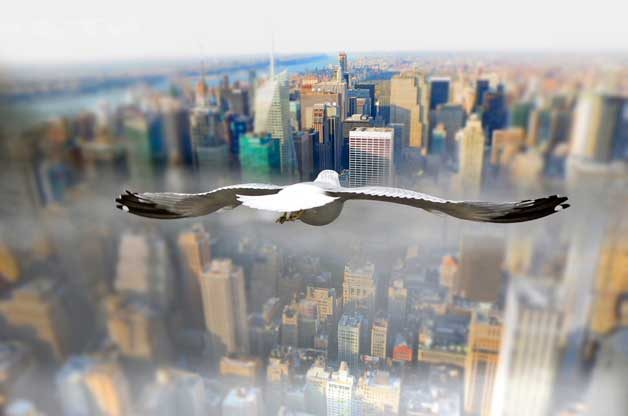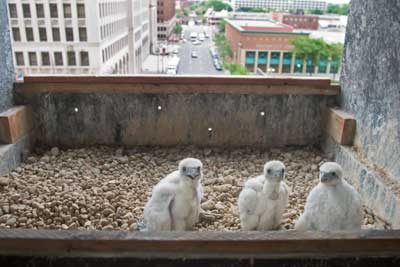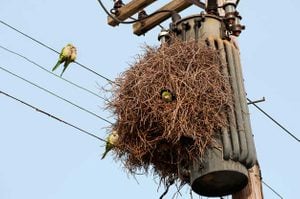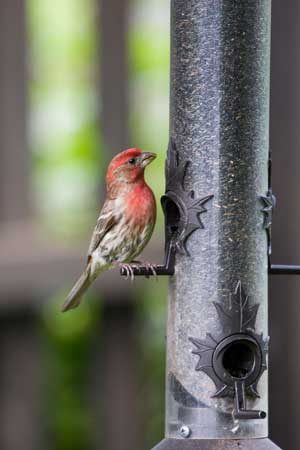City Birds in Urban Birding Hotspots
Updated: Jan. 19, 2024

Meet some of the most common city birds that live in urban birding hotspots today, and find out how they're adapting to downtown life.
“Birds are everywhere.” We’re always telling people that—especially when we’re trying to convince them you can go bird-watching anywhere. And it’s true. Birds are everywhere, from forests to prairies, from swamps to deserts to suburban yards. But can our metropolitan cities also serve as centers of bird life?
Actually, yes, they can. Surprising numbers of birds can be found even among the concrete and glass of our largest cities. Here are a few examples of birds that you might see among concrete jungles.
CITY BIRDS ADAPTING TO URBAN LIFESTYLES
When we think about city birds, some that come to mind first include pigeons, house sparrows and starlings. It makes sense that they would thrive in the city, because these are all birds imported from Europe. Over the course of many centuries, as European towns developed and grew into cities, these birds had time to adapt to the changes. When human settlers from Europe came to North America and started to build cities here, these imported birds had a head start over our native species.
Adaptability is the key, and many native North American birds are proving to be adaptable as well. One prime example is the house finch. Originally found in the western U.S. and Mexico, this colorful songster probably learned to live around the villages of the Hopi, the Navajo and other Native American people in the Desert Southwest. When the house finch was accidentally introduced into the New York area in 1940, it soon adapted to eastern cities and started to spread. The new eastern population met the expanding western flocks on the Great Plains in the 1990s, and today house finches are found in cities and towns from coast to coast.
INNOVATIVE NESTERS
Some birds have very simple needs. They find their food in the air, so all they need is a place to build their nests. The chimney swift is a perfect example. It catches flying insects in high, swift flight, ranging for miles every day in search of airborne bugs. Centuries ago it built its nests in large hollow trees in the forest. Today, large hollow trees are harder to find, but every city has chimneys. The swifts use their sticky saliva to paste a small platform of twigs to the inside of a chimney, creating a secure nest where they can lay their eggs.
Other aerial insect-eaters also find nesting sites downtown. The common nighthawk will lay its eggs directly on a gravel roof, where they are perfectly camouflaged. Cliff swallows will build their mud nests on the sides of buildings, but in more and more cities they are now placing those nests under bridges, where they are better protected from weather.

Even birds of prey find places to nest among the concrete canyons. The peregrine falcon, the world’s fastest flying bird, will lay its eggs on ledges of skyscrapers in our largest cities. These urban peregrines often hunt high above the streets, chasing pigeons. In recent years, red-tailed hawks also have moved into cities, nesting on buildings and hunting squirrels and sparrows in the local parks. The most famous urban red-tail, New York City’s “Pale Male,” has even been the subject of a book and a movie.
MORE NEW KIDS IN TOWN
In cities located along the shores of the ocean, lakes or large rivers, some birds take advantage of the specific habitat parking lots have to offer. They are favorite haunts of ring-billed gulls. Most kinds of gulls are opportunists anyway, and ring-bills are quick to adopt large open parking lots as places to rest, their flocks lining up and facing into the wind. Parking lots next to fast-food restaurants are especially popular, as the gulls can usually find choice leftovers dropped on the pavement.
At one time, crows and ravens were absent from American cities. Crows lived in wide-open farm country and ravens were mostly wilderness birds. They were often shot, and they had learned to avoid humans. But in recent decades, these intelligent and adaptable birds must have noticed that they weren’t in danger when they ventured into suburbs and cities, so they moved right in. American crows now live in many cities from coast to coast, while common ravens thrive in some downtown areas of the West, like Phoenix and San Francisco. The stately raven of Poe’s poem can even be seen perched on neon signs in Las Vegas.

One of the most surprising and colorful urban birds is the monk parakeet. With its shrill voice and bright green plumage, it seems out of place on our city streets—and it is, since it’s native to South America, and was brought here as a cage bird. But in many parts of the U.S., monk parakeets have escaped from captivity, found each other and formed colonies. Dallas, Miami, Chicago and other big urban centers have thriving flocks of these flashy birds. They often build their bulky nests on power poles or substations, and show up at bird feeders alongside sparrows and other less colorful creatures.
TEMPORARY GUESTS
During much of the year, only a few of the most adaptable birds can be found downtown. But the sky’s the limit during spring and fall migration seasons, because migrating birds may drop in anywhere. We have seen thrushes, warblers
and other woodland species pausing among the skyscrapers in Boston, Philadelphia, Houston, Los Angeles and many other large cities. All they need
are a tree or two to forage and places to rest for their next flight. So keep your eyes open all the time, because birds really are everywhere!
Kenn and Kimberly Kaufman live out in the country in Ohio, but they relish the chance to go birding in big cities several times a year.

6 BIRD-FRIENDLY CITIES
While every city offers the chance to see some birds, a few of them have embraced birding in notable ways.
- Portland, Oregon. From great blue herons living along rivers in town to swifts roosting in local chimneys, Portland finds ways to celebrate all kinds of urban birds.
- New York City. America’s biggest city hosts an astonishing variety of birds, especially in parks like Central Park, where organized bird walks are held almost every day in spring and fall.
- Milwaukee, Wisconsin. Its location along Lake Michigan makes this a prime birding city all year. From ducks and gulls in winter to migrating hawks in fall and warblers in spring, there are always birds to see in Milwaukee’s parks and nature centers.
- Tucson, Arizona. Since 2001, Tucson has organized a citywide bird count every spring. Cactus wrens, verdins, curve-billed thrashers and other desert birds thrive even in the heart of town.
- Austin, Texas. Austin is famous for live music and other cultural highlights, but it’s also a hub of birding activity. Lakes and parks along the Colorado River bring abundant bird life to the city center.
- St. Petersburg, Florida. Surrounded on three sides by the waters of Tampa Bay, the city teems with birds in all seasons, including pelicans, egrets, ospreys and more. Migration brings warblers and other songbirds to every park in town.
